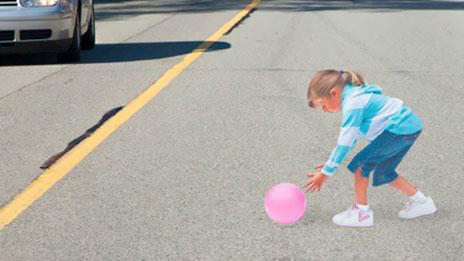|
查看原文
When conventional road signs have no effect, designers are turning to increasingly clever ways to subconsciously make drivers slow down or pay attention.
Lights which last 25 years are cutting Jersey's street lighting bill in half and may improve road safety.
A spooky, black human silhouette suddenly appeared out of nowhere on the roadside of a picturesque country road in southern France. It was the size of an adult, but it had no face; instead, a lightning bolt seemed to split its head in two.
Speeding down this road with no traffic, no lampposts and no speed traps – just ancient plane trees towering on both sides – I dismissed the figure as a weird prank. But then there was another. And then two more, an adult and what looked like a child. Then it dawned on me. The cut-outs represented people who died on this road in car accidents. The message came across: I slowed down.
It’s a not-too-subtle example of a strategy known as behavioural science or nudging – techniques that make people act or respond in a certain manner. Some nudging tactics are straightforward or obvious. Signs displaying speed, speed limits or reminding drivers to take regular breaks try to capture the driver’s attention directly. Others are more subtle; like the “average speed” cameras. While normal speed traps try to catch speeding drivers at one single spot, average speed cameras punish drivers who cover the distance between point A and B too fast. The nudging works: when in 2005 average speed cameras were installed on a 32-mile stretch of the A77 motorway near Glasgow in Scotland, the amount of road casualties fell 37%.
Then there are measures that tap more into the subconscious. Some road construction sites use smiley signs to influence driver behaviour: At the start of the road works the smiley is sad – but it gets progressively happier as you’re nearing the end of the construction zone. The goal is to keep drivers alert and decrease their frustration while they have to keep to a lower speed limit. In a similar vein speed boards in the UK have had a smiley added underneath. They smile at cars under the speed limit, and frown at those that go above it.
Bumping behaviour
Roads in some countries are clearly more dangerous than in others. India accounts for 10% of all road fatalities – about 137,000 people died on Indian roads in 2011 alone. Even though the country’s first access-control motorway – the six-lane Mumbai-Pune Expressway is relatively less dangerous than cramped urban streets, there have been more than 2,000 accidents, with at least 500 fatalities, in its 12 years of operation. Nudging is one way of dealing with the problem. Final Mile is a Mumbai-based behavioural science and design firm that hopes it can play mind tricks with Indian drivers to persuade them to slow down and pay more attention.
More than three-quarters of accidents happen because of a human error, says Ram Prasad, one of the company's co-founders. Specifically, five aspects of human nature are at play: overconfidence; inattention; skewed perception of risk; lack of feedback; and lack of empathy – due to poor eye contact at high speeds.
So, to get overconfident and inattentive drivers to slow down at India’s more than 13,000 open railway crossings, Final Mile has installed speed-bumps that run diagonally, rather than perpendicular, to the road. The front wheels of a car cross the bump one after the other, rather than in unison, making the car swing from side to side. “They bring in unfamiliarity,” says Prasad, “motorists tend to slow down significantly and therefore pay more attention to an oncoming train.” On the Mumbai-Pune Expressway, these speed-breakers are also painted with thicker yellow lines, making them appear higher. This tricks the drivers, forcing them to reduce speed before approaching them.
Going the extra smile
Another tactic is to humanise signage. The black silhouettes on French and Canadian roads are one example, large posters in India showing shocking pictures of a man’s face in a crash are another. “This builds empathy,” says Prasad. “And instead of just saying ‘drive slowly', we show what happens if you drive fast,” he says.
On some UK roads the familiar “Children crossing” sign with outlines of running children has been replaced by black life-size silhouettes of children instead. It works even better if “the children featuring on the poster are saying ‘I live here,’ or ‘I want my daddy to come home safely',” says Pelle Guldborg Hansen, behavioural scientist at the University of Southern Denmark, and chairman of the Danish Nudging Network.
This makes the impact of aggressive driving very obvious, and creates awareness in an automatic, effortless way – which is crucial, says Ivo Vlaev, an experimental psychologist at Imperial College London in the UK.
It falls in-between the extremes of calling attention to your speed and a perception of a possible risk.
Another nudge by illusion is a reminder of the force of the law by using fake police officers. In Bangalore, life-size khaki-clad cardboard cut-outs of policemen are used to persuade drivers to behave. Similar tricks are used in China, the United States and some European countries. In Preston, a town in the UK, motorists hit the brakes after mistaking life-sized metal replicas for real police officers. Some towns have placed life-size cardboard cut-outs of police cars on bridges crossing highways.
|
查看译文
当常规道路标志不起效果的时候,设计师正转向一个更聪明的方式去让司机下意识减速或引起他们的注意。
持续了25年的路灯在新泽西的街道照明预算中削减到一半,且可以改善道路的安全。
一个怪异的人形黑影突然出现在法国南部的一个风景如画的乡村公路上。这是一个成年人的体形,但是没有脸;一道闪电似乎把它的头劈成了两半。
沿着这条没有交通拥挤,没有路灯,没有限速,只是两边种满树木的道路上加速,我把这个景象当作一个奇怪的恶作剧。但是之后又出现了另一个,然后又出现两个,一个成年人和一个看起来像孩子一样的人。然后我恍然大悟。这个景象代表了在这条路上出车祸去世的人们。我领会到了它要传达的信息:我车速慢了下来。
这一不太微妙的策略被称为行为科学——这个技术,使人以某种方式行动或是做出回应。一些“督促”策略是直白或是明显的。标识牌显示速度、速度限制或是通过一些有规律的变化来直接引起司机的注意。其他的更加微妙,像“平均速度”相机。当规定一个正常速度来捕捉超速驾驶者在某一点的速度时,平均速度相机就会捕捉下来,惩罚从A到B点距离超速的司机。这些相机被用在:2005年时的平均速度的相机被安装在苏格兰的格拉斯哥附近的一个32英里的A77高速公路上,道路伤亡数量下降了37%。
还有更多利用潜意识的措施。一些道路建筑工地用笑脸符号影响司机的驾驶行为:在刚进入道路施工区时那个笑脸是悲伤的——但是当你靠近施工区的尽头时它会逐渐快乐起来。它的目标是保持司机警惕,当他们不得不保持一个较低的速度限制时,降低他们的失落心情。本着同样的目的,在英国速度主板下面会添加一个笑脸。它们对低于限速行驶的汽车微笑,对超过限速的汽车皱眉。
碰撞行为
一些国家的道路明显比其他国家的更加危险。印度占所有道路死亡的10%——仅在2011年在印度的道路上就有大约13.7万人死亡。即使在该国首条限行的车道上(有六条行车线的孟买-浦那高速公路),在投入使用的12年内,也发生了2000多起事故,其中至少有500起死亡事故,尽管这条路比拥挤的城市街道相对安全些。“督促”是一种处理问题的方式。孟买行为科学和设计公司“最后一英里”希望它能利用心理战术劝印度司机开慢点,对道路安全多加重视。
该公司创始人之一拉姆•普拉萨德说,超过四分之三的事故的发生是由于人为错误。具体来说,是人性的五个方面在起作用:过度自信,注意力不集中,不正确的风险意识,缺乏反馈,以及缺乏同情心——因为在高速路上不能进行眼神交流。
因此,为了让过度自信和粗心的司机在印度1.3万多个开放铁路道口放慢速度,“最后一里”安装了颠簸的斜线减速带,而不是垂直的。汽车的前轮通过一个又一个的颠簸,而不是一致的,使汽车不停的摆动。普拉萨德说:“他们带来了不一样的感觉,驾车者往往都明显地速度变慢,因此更会注意到列车驶来。”在孟买-浦那高速公路,这些减速带也涂有厚厚的黄线,使他们显得更高。这迫使司机们在接近他们的时候减速。
额外的微笑
另一个策略是以人为本的标志。法国和加拿大道路上的黑色影子就是一个例子,另一个例子是印度的一个大海报呈现的在一次车祸中的男人震惊的脸。普拉萨德说:“这个海报使人感同身受,相比只是说一句‘慢速驾驶’,我们展示了如果你开车太快会发生什么。”
在英国的一些道路就有很熟悉的“儿童通行”的标志,用黑色的真人大小的孩子的轮廓代替奔跑的孩子。佩尔古尔堡汉森是南丹麦大学的行为科学家和丹麦网络主席,他说:“它甚至比海报上的孩子们说,我住在这里,或者我希望我爸爸能平平安安回家的效果更好。”
“这使得攻击性驾驶的后果非常明显,而且自然而然、毫不费力就灌输了这一意识,这是至关重要的”,英国伦敦帝国学院的实验心理学家伊沃说道。
它既能让你注意车速,也能让你意识到可能发生的危险后果。
另一个通过幻象进行督促的例子是用“假警察”来提醒人们遵守法律。在班加罗尔,真人大小的土包纸板警察被用来震慑司机。类似的方法在中国、美国和一些欧洲国家也在使用。在英国的一个小镇上,驾驶者踩刹车,因为把真人大小的纸板误认为是真警察。一些城镇在跨越公路的桥梁上放置和警车同样大小的纸板“假警车”。
(译者 1101王靓 编辑 丹妮)
扫一扫,关注微博微信
 
|

